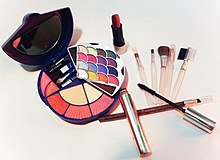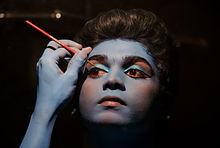
Back مستحضر تجميل Arabic Cosméticu AST Косметика Bashkir Касметыка Byelorussian Касмэтыка BE-X-OLD Alat dandanan BEW Козметика Bulgarian Kozmetika BS Cosmètica Catalan Kosmetiko CEB
This article needs additional citations for verification. (October 2020) |



Cosmetics are composed of mixtures of chemical compounds derived from either natural sources or synthetically created ones.[1] Cosmetics have various purposes, including personal and skin care. They can also be used to conceal blemishes and enhance natural features (such as the eyebrows and eyelashes). Makeup can also add colour to a person's face, enhance a person's features or change the appearance of the face entirely to resemble a different person, creature, or object.[2]
People have used cosmetics for thousands of years for skin care and appearance enhancement. Visible cosmetics for women and men have gone in and out of fashion over the centuries.
Some early forms of cosmetics used harmful ingredients such as lead that caused serious health problems and sometimes resulted in death. Modern commercial cosmetics are generally tested for safety but may contain controversial ingredients, such as per- and polyfluoroalkyl substances (PFAS), formaldehyde releasers, and ingredients that cause allergic reactions.
The European Union and regulatory agencies around the world have stringent regulations for cosmetics. In the United States, cosmetic products and ingredients do not require FDA approval. Some countries have banned using animals for cosmetic testing.
- ^ Schneider, Günther; Gohla, Sven; Schreiber, Jörg; Kaden, Waltraud; Schönrock, Uwe; Schmidt-Lewerkühne, Hartmut; Kuschel, Annegret; Petsitis, Xenia; Pape, Wolfgang (2001). Skin Cosmetics. Ullmann's Encyclopedia of Industrial Chemistry. John Wiley & Sons, Ltd. doi:10.1002/14356007.a24_219. ISBN 978-3-527-30673-2. OCLC 910197915. Archived from the original on 21 February 2022. Retrieved 2022-02-21.
- ^ Nutrition, Center for Food Safety and Applied (2023-03-16). "Cosmetics & U.S. Law". FDA. Archived from the original on 2023-11-05. Retrieved 2023-11-05.